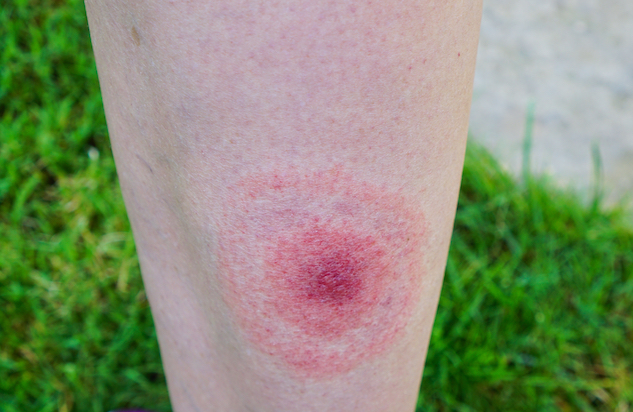6 Myths About Lyme Disease Debunked
With scientists and ecologists across the country warning that 2017 will likely be the worst year for Lyme disease yet, it’s time you learn the truth about ticks.
Photo by Cherries/Shutterstock
This article is not meant to diagnose or provide medical advice—that responsibility lies with physicians. The author is not a licensed medical professional.
By now, you’ve probably heard the Lyme disease horror stories of celebrities like Avril Lavigne, Yolanda and Bella Hadid, Ally Hilfiger, Kris Kristofferson and Kelly Osbourne as they recounted the details of the struggle to regain their health. But is Lyme disease as brutal as they suggest?
Unfortunately, many people are unaware that Lyme disease, a bacterial infection called Borrelia transmitted through the bite of a tick, is the most commonly reported vector-borne illness in the United States. You are probably most familiar with the vector-borne diseases transferred by mosquitoes (such as the West Nile virus, the Zika virus and various encephalitis-causing viruses). But Lyme disease is the most prevalent infection contracted by creatures that seek to poke you and feast on your blood.
According to the CDC, there are 329,000 cases of Lyme disease reported annually in the United States. But some Lyme specialists believe that number may be a conservative estimate, and actual incidences are closer to 400,000. Regardless, Lyme disease is one of the fastest growing infectious diseases in the country. Ticks are most active from the spring through the fall. However, it’s possible to be infected year-round, especially if your winter months are above freezing. While there’s a heap of medical and political controversy surrounding Lyme disease, firsthand accounts from patients will tell you this illness isn’t something to take lightly; the risk of delaying proper treatment or receiving a misdiagnosis has the potential to derail your life.
With scientists and ecologists across the country warning that 2017 will likely be the worst year for Lyme disease yet, it’s time you learn the truth about ticks and their infections.
1. Ticks Are Only Found in Wooded Areas of the Northeast
The nonprofit, medical organization International Lyme and Associated Diseases Society (ILADS) states, “Lyme disease is transmitted by the bite of a tick, and the disease is prevalent across the United States and throughout the world. Ticks know no borders and respect no boundaries. A patient’s county of residence does not accurately reflect his or her Lyme disease risk because people travel, pets travel, and ticks travel. This creates a dynamic situation with many opportunities for exposure to Lyme disease for each individual.”
Furthermore, a 2016 study showed half of all U.S. counties now report Lyme-disease carrying ticks. Because ticks need blood meals to survive, they live near their potential hosts. In addition to wooded areas, they are often found in our most popular outdoor spaces such as parks, fields, overgrown grass, nature preserves, gardens, beaches and yes, even in cities.
2. You’ll Be Able to Feel a Tick Bite When It Occurs
On the contrary, says Lyme specialist and author of Unlocking Lyme, William Rawls, M.D. “Tick saliva has remarkable properties. Not only does it numb the skin so the host doesn’t feel the bite, it also suppresses immune functions against the invader.” In short, a tick bite is likely to go undetected.
3. I Couldn’t Have Contracted Lyme disease Because I Never Saw a Tick
If only it were that simple. Most people who contract Lyme disease never laid eyes on the bloodsucking arachnid that made them sick. In fact, ILADS reports fewer than 50 percent of people with Lyme disease recall a tick bite. Moreover, a study dating back to 2001 by Yale University researcher, Durland Fish, found that as few as 20 percent of patients with the illness remembered a tick bite.
There are two primary reasons tick bites go unnoticed. First, ticks can be tiny (about the size of a poppy seed in their immature, nymphal stage). Second, they often hide in warm places on the body (like under the arms, in the belly button, in the hair, behind the knees and on the genitalia).
4. I Never Had a “Bull’s-eye” Rash, Therefore, I’m Fine

Photo by by AnastasiaKopa/Shutterstock
Statistically speaking, less than half of patients with Lyme disease will display a rash. As stated by ILADS, “Although the erythema migrans or ‘bull’s-eye’ rash is considered classic, it is not the most common dermatologic manifestation of early-localized Lyme infection. Atypical forms of this rash are seen far more commonly.” Should you happen to be in the minority of people who develop a bull’s-eye rash, ILADS points out, this rash is a telltale sign of Lyme disease and once a doctor sees it, they are likely to begin antibiotic therapy. If an unusual looking rash pops up after being in a potentially risky area, you should consider looking into whether or not you’ve been infected. A physician versed in Lyme disease may prescribe a prophylactic course of medication to catch the condition early.
5. When I’m Infected, I’ll Know Right Away
“The symptoms associated with acute or early Lyme disease are usually very mild. In fact, most people aren’t even aware of symptoms,” explains Dr. Rawls. “Typical symptoms that can occur include fatigue, flu-like symptoms, low-grade fever and chills, stiff neck, and sometimes a rash. But again, symptoms of initial infection often go unnoticed.”
When health care providers fail to diagnose and treat Lyme disease early, it can become chronic, states the education, advocacy and research group, LymeDisease.org. They note chronic Lyme disease may also occur if initial treatments for the illness are insufficient.
Additionally, Lyme disease can affect any part of the body, impact many body systems, and its symptoms mimic many other diseases. Sadly, many people won’t be correctly diagnosed with Lyme disease until their symptoms have become severe, they aren’t getting well with other treatments, or they’ve consulted with a Lyme specialist (called a Lyme Literate Medical Doctor or LLMD). This is the stage at which most of the celebrities you’ve come to associate with Lyme disease began sharing their stories.
6. My Doctor Said I Don’t Have Lyme Disease Because My Test Results Were Negative

Photo by by Jarun Ontakrai/Shutterstock
How can we put this gently … Bullshit. Lab work like the ELISA and the standard western blot test for acute infections and their accuracy are limited to a small window of time-approximately four to six weeks post infection. If you test before or after this timeframe, you’re likely to receive a negative result. Peer-reviewed studies show the current methods of testing may miss more than 50 percent of cases; many experts agree the available testing for Lyme disease remains woefully inaccurate. For this reason, Lyme disease is a diagnosis based on a patient’s clinical presentation of symptoms, medical history and possible exposure to ticks.
Plus, it’s not just about a single microbe that should give you cause for concern. “The testing that is available is only scratching the surface. There are a dozen known Borrelia species and literally hundreds of other microbes that can be spread by ticks,” says Dr. Rawls. “Currently, we test for only a handful. And, those are the ones we know about; there are likely many more yet to be discovered.”
***
Bottom line? Lyme disease is a silent epidemic, and many people are misdiagnosed through various stages of the illness. If you don’t feel well, be your own advocate and seek out a second (or third) opinion from a physician who specializes in the diagnosis and treatment of Lyme disease. With appropriate intervention and a heavy dose of persistence, your symptoms and health can improve.
Jenny Lelwica Buttaccio OTR/L is a Chicago-based freelance lifestyle writer and a licensed and registered occupational therapist with expertise in health, wellness, fitness, chronic illness management and business.







































